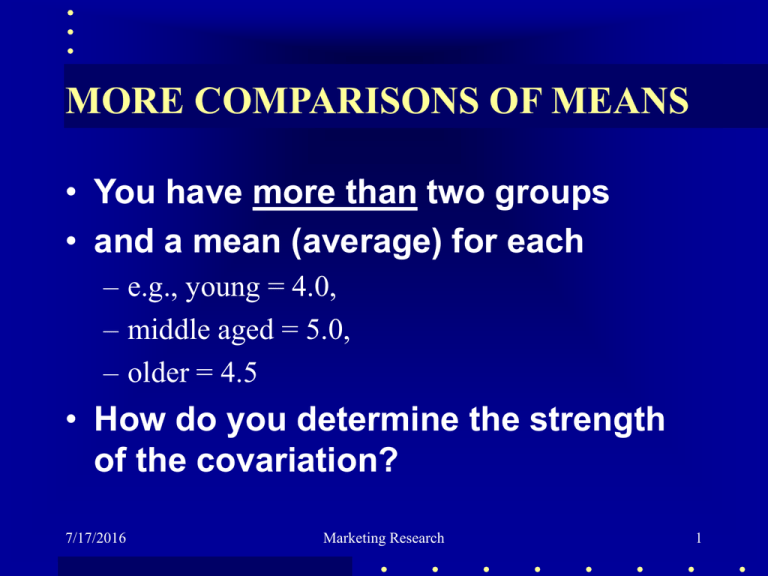
MORE COMPARISONS OF MEANS
• You have more than two groups
• and a mean (average) for each
– e.g., young = 4.0,
– middle aged = 5.0,
– older = 4.5
• How do you determine the strength
of the covariation?
7/17/2016
Marketing Research
1
ANOVA
– Decomposes “variance” into:
• treatment effects
• other factors
• unexplained factors
– Compares data to group means
• Subtracts each data point from group mean
• Squares it
• Keeps a running total of “Sum of Squares”
7/17/2016
Marketing Research
2
ANOVA
– The Sums of Squares are then:
• Divided by the number of groups
• (To get an estimate “per group”)
– “Mean Squares”
• MSSr = SSr / df
– (variance per group)
• MSSr / MSSu = F
– Total variance “explainable”
– F compared to F crit [dfn, dfd]
– if F > F crit, difference in population
7/17/2016
Marketing Research
3
ANOVA (continued)
– One way ANOVA investigates:
– Main effects
• factor has an across-the-board effect
• e.g., age
• or involvement
7/17/2016
Marketing Research
4
Example
• Study of movie profits
– Dependent variable:
• Gross revenue in dollars [continuous]
– Independent variables:
• Sex [categorical]
• Violence
– Examine predictors of profitability:
• Sex, violence, interaction (sex * violence)
7/17/2016
Marketing Research
5
Main effect: Sex
5
4
No sex
Sex
3
2
Low
7/17/2016
VIOLENCE LEVEL
Marketing Research
High
6
Main effect: Violence
5
4
No sex
Sex
3
2
Low
7/17/2016
VIOLENCE LEVEL
Marketing Research
High
7
ANOVA
– A TWO-WAY ANOVA investigates:
– INTERACTIONS
• effect of one factor depends on another factor
• e.g., larger advertising effects for those with no
experience
• importance of price depends on income level and
involvement with the product
7/17/2016
Marketing Research
8
Interaction: Sex by Violence
5
4
No sex
Sex
3
2
Low
7/17/2016
VIOLENCE LEVEL
Marketing Research
High
9
Example
• Study of movie profits
– Dependent variable:
• Gross revenue in dollars [continuous]
– Independent variables:
• Sex [categorical]
• Violence
– Examine predictors of profitability:
• Sex, violence, interaction (sex * violence)
7/17/2016
Marketing Research
10
SPSS Output
Tests of Between-Subjects Effects
Dependent Variable: Total Gross
Type III Sum
Source
of Squares
Corrected Model
43744.364 a
Intercept
952785.362
SEX
35467.649
VIOLENCE
10228.369
SEX * VIOLENCE
21.589
Error
995088.361
Total
1991539.265
Corrected Total 1038832.725
a.
R Squared
7/17/2016
df
3
1
1
1
1
381
385
384
Mean Square
14581.455
952785.362
35467.649
10228.369
21.589
2611.780
= .042 (Adjusted R Squared
.035)
Marketing =
Research
F
5.583
364.803
13.580
3.916
.008
Sig.
.001
.000
.000
.049
.928
11
MULTIVARIATE STATISTICS
Previous statistics:
• Crosstabs (chi-square)
• t-test (means)
• Analysis Of Variance (ANOVA)
• Pearson’s correlation coefficient
• Regression
• Multiple regression
7/17/2016
Marketing Research
12
Next couple of statistics:
• used less frequently
• (bottom of your “tool box”)
• more “exploratory”
1. Discriminant analysis
2. Factor analysis
3. Cluster analysis
7/17/2016
Marketing Research
13
1. Discriminant analysis
• Tests for covariation between:
• Categorical dependent variable
– “group” such as purchaser, non purchaser;
– regular, occasional, and infrequent purchasers;
– people who like “chick” flicks, those that like
“guy flicks,” those that like both
• Continuous and categorical IVs
– age, income, gender, etc.
7/17/2016
Marketing Research
14
1. Discriminant analysis (continued)
• which variables “group” people?
• coefficients reveal importance of factors
– larger coefficient, more important
– smaller coefficient, less important
• p-value associated with specific variables
• overall fit assessed by “% correctly
classified”
7/17/2016
Marketing Research
15
2. Factor analysis
• examines covariation between:
• several different variables
• that are “reduced” to one or more
underlying “factors” or “constructs”
– e.g., overall “intelligence,” “need to consume,” etc.
• often used to develop scales of related
questions -- “data reduction”
• no information on what causes what
7/17/2016
Marketing Research
16
2. Factor analysis (continued)
• attempts to identify the most shared
variation
– the first factor is the largest amount of “variance”
– the second factor is the second largest variance, etc.
• Number of “factors”
– “Eigenvalues” > 1.0 (“chance”)
– “bend in the “Scree plot”
7/17/2016
Marketing Research
17
3. Cluster analysis
• Covariation among a number of
variables
• Identifies “segments” of the sample
• Used frequently in marketing
• Helpful for targeting products and
messages
7/17/2016
Marketing Research
18
4. Multi-Dimensional Scaling
• abbreviated “MDS”
• Subject rate “distances” or differences
between objects
• Data are subjected to analysis
• Analysis reveal underlying “dimensions”
• Used to identify how people differentiate
products
7/17/2016
Marketing Research
19
The End
7/17/2016
Marketing Research
20

